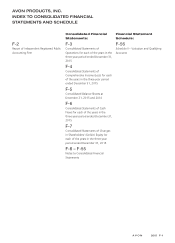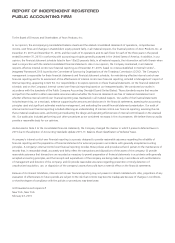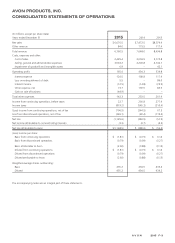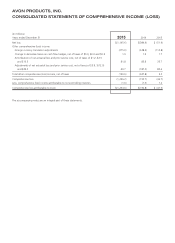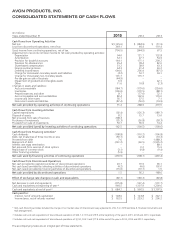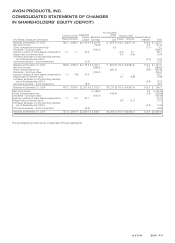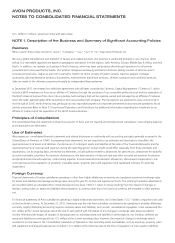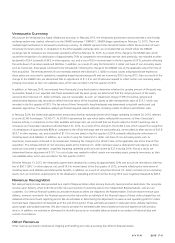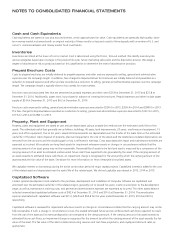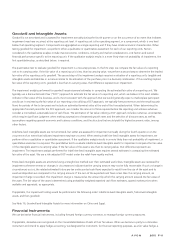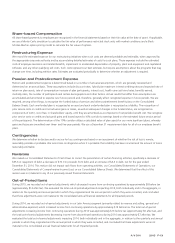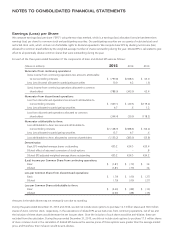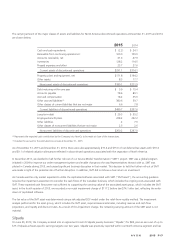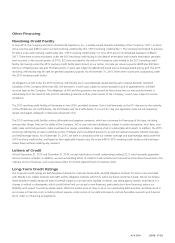Avon 2015 Annual Report Download - page 93
Download and view the complete annual report
Please find page 93 of the 2015 Avon annual report below. You can navigate through the pages in the report by either clicking on the pages listed below, or by using the keyword search tool below to find specific information within the annual report.Goodwill and Intangible Assets
Goodwill is not amortized and is assessed for impairment annually during the fourth quarter or on the occurrence of an event that indicates
impairment may have occurred, at the reporting unit level. A reporting unit is the operating segment, or a component, which is one level
below that operating segment. Components are aggregated as a single reporting unit if they have similar economic characteristics. When
testing goodwill for impairment, we perform either a qualitative or quantitative assessment for each of our reporting units. Factors
considered in the qualitative analysis include macroeconomic conditions, industry and market considerations, cost factors and overall
financial performance specific to the reporting unit. If the qualitative analysis results in a more likely than not probability of impairment, the
first quantitative step, as described below, is required.
The quantitative test to evaluate goodwill for impairment is a two-step process. In the first step, we compare the fair value of a reporting
unit to its carrying value. If the fair value of a reporting unit is less than its carrying value, we perform a second step to determine the implied
fair value of the reporting unit’s goodwill. The second step of the impairment analysis requires a valuation of a reporting unit’s tangible and
intangible assets and liabilities in a manner similar to the allocation of the purchase price in a business combination. If the resulting implied
fair value of the reporting unit’s goodwill is less than its carrying value, that difference represents an impairment.
The impairment analysis performed for goodwill requires several estimates in computing the estimated fair value of a reporting unit. We
typically use a discounted cash flow (“DCF”) approach to estimate the fair value of a reporting unit, which we believe is the most reliable
indicator of fair value of this business, and is most consistent with the approach that we would generally expect a marketplace participant
would use. In estimating the fair value of our reporting units utilizing a DCF approach, we typically forecast revenue and the resulting cash
flows for periods of five to ten years and include an estimated terminal value at the end of the forecasted period. When determining the
appropriate forecast period for the DCF approach, we consider the amount of time required before the reporting unit achieves what we
consider a normalized, sustainable level of cash flows. The estimation of fair value utilizing a DCF approach includes numerous uncertainties
which require significant judgment when making assumptions of expected growth rates and the selection of discount rates, as well as
assumptions regarding general economic and business conditions, and the structure that would yield the highest economic value, among
other factors.
Indefinite-lived intangible assets are not amortized, but rather are assessed for impairment annually during the fourth quarter or on the
occurrence of an event that indicates impairment may have occurred. When testing indefinite-lived intangible assets for impairment, we
perform either a qualitative or quantitative assessment. If the qualitative analysis results in a more likely than not probability of impairment, a
quantitative assessment is required. The quantitative test to evaluate indefinite-lived intangible assets for impairment compares the fair value
of the intangible asset to its carrying value. If the fair value of the asset is less than its carrying value, that difference represents an
impairment. The impairment analysis performed for indefinite-lived intangible asset requires several estimates in computing the estimated
fair value of the asset. We use a risk-adjusted DCF model under the relief-from-royalty method.
Finite-lived intangible assets are amortized using a straight-line method over their estimated useful lives. Intangible assets are reviewed for
impairment whenever events or changes in circumstances indicate that the carrying amount may not be fully recoverable. If such a change in
circumstances occurs, the related estimated future pre-tax undiscounted cash flows expected to result from the use of the asset and its
eventual disposition are compared to the carrying amount. If the sum of the expected cash flows is less than the carrying amount, an
impairment charge is recorded. The impairment charge is measured as the amount by which the carrying amount exceeds the fair value of
the asset. The fair value of the asset is determined using probability weighted expected cash flow estimates, quoted market prices when
available and appraisals, as appropriate.
If applicable, the impairment testing would be performed in the following order: indefinite-lived intangible assets, finite-lived intangible
assets, and then goodwill.
See Note 16, Goodwill and Intangible Assets for more information on China and Egypt.
Financial Instruments
We use derivative financial instruments, including forward foreign currency contracts, to manage foreign currency exposures.
If applicable, derivatives are recognized on the Consolidated Balance Sheets at their fair values. When we become a party to a derivative
instrument and intend to apply hedge accounting, we designate the instrument, for financial reporting purposes, as a fair value hedge, a
A V O N 2015 F-11
7553_fin.pdf 83


